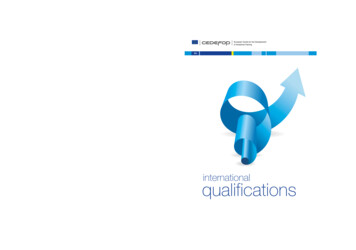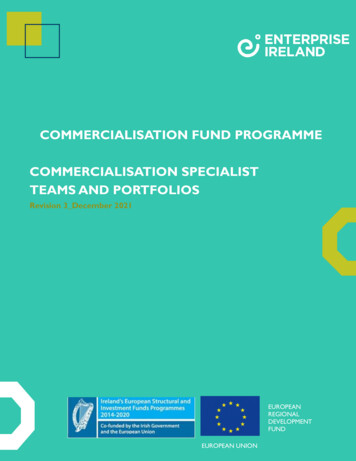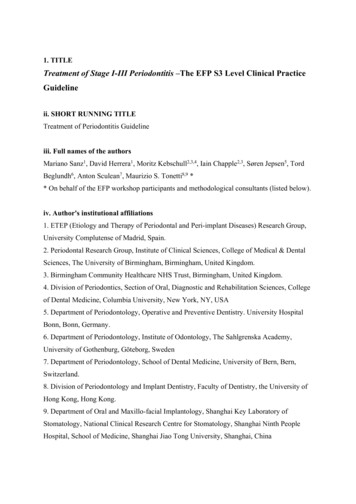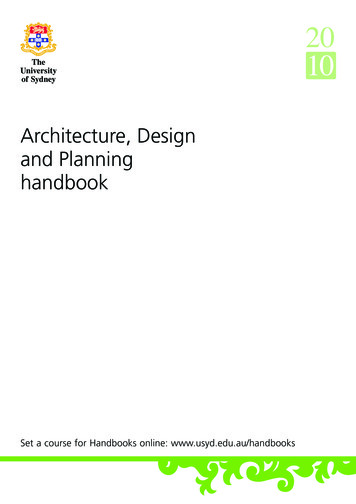
Transcription
ENENinternationalqualifications4116 EN – TI-31-12-754-EN-CAn increasing number of qualifications – certificates anddiplomas – are awarded at international level, outside thejurisdiction of national authorities. These ‘non-State’qualifications have been developed and are awarded by awide range of bodies, organisations and companiesaddressing various purposes. What unites this extremevariety of qualifications is that they are not restricted to aparticular national system or territory. They are allqualifications whose exchange value is defined outsidetraditional national qualifications systems. This raises somekey questions and challenges for policy-makers as well asusers – be they individual citizens or employers. This reportis a first effort to increase transparency in this field, notablyby pointing to existing sources and clarifying the concepts tobe used for mapping and analysis.European Centre for the Developmentof Vocational TraininginternationalEurope 123, 570 01 Thessaloniki (Pylea), GREECEPO Box 22427, 551 02 Thessaloniki, GREECETel. 30 2310490111, Fax 30 2310490020, E-mail: info@cedefop.europa.euISBN 978-92-896-1117-6qualifications
International qualificationsLuxembourg:Publications Office of the European Union, 2012
A great deal of additional information on the European Unionis available on the Internet.It can be accessed through the Europa server (http://europa.eu).Cataloguing data can be found at the end of this publication.Luxembourg:Publications Office of the European Union, 2012ISBN 978-92-896-1117-6doi: 10.2801/8721Copyright @ European Centre for the Developmentof Vocational Training (Cedefop), 2012. All rights reserved.Designed by adam@artdirector.grPrinted in the European Union
The European Centre for the Developmentof Vocational Training (Cedefop) is the European Union'sreference centre for vocational education and training.We provide information on and analyses of vocationaleducation and training systems, policies, research and practice.Cedefop was established in 1975by Council Regulation (EEC) No 337/75.Europe 123, 570 01 Thessaloniki (Pylea), GREECEPO Box 22427, 551 02 Thessaloniki, GREECETel. 30 2310490111, Fax 30 2310490020E-mail: an F. Lettmayr, Acting DirectorHermann Nehls, Chair of the Governing Board
ForewordMany and very diverse qualifications, diplomas, certificates and licences areawarded outside the jurisdiction of public authorities, including by multinationalcompanies, so there is a need to analyse further the character and typologyof these qualifications, their credibility and value on the labour market, both forindividuals and employers.While international qualifications can be of relevance for the labour marketthey are also important in national and European perspectives as they promotecommon trust and cooperation at operational level. International qualificationsfeed in the context of the development and implementation of two Europeaninitiatives; the European qualifications framework (EQF) and the Europeanclassification of skills/competences, qualifications and occupations (ESCO).The EQF 2008 recommendation also specifies the need to increasetransparency of qualifications awarded at international level, a challenge stillnot addressed systematically by the EQF. On the other hand, internationalqualifications are part of ESCO work in the qualifications pillar illustrating howawards influence the right to access and practise an occupation or task.From experience gained from EQF/NQF (national qualifications framework)developments and ESCO work we observe there is high complexity inpurpose, type, coverage, currency and competent bodies involved. Thisbooklet is a first attempt to work on a typology of international qualifications,to present examples from various sectors and occupations, and finally tocontribute to their better understanding to provide a basis for future EQF andESCO developments.Christian F. LettmayrActing Director of Cedefop
AcknowledgementsThis paper presents results of researchcarried out by Cedefop on qualifications andlearning outcomes. It reflects the work ofLoukas Zahilas who wrote the report with thevaluable support and contribution of JensBjornavold, both senior experts at Cedefop.Thanks are due to Philippe Tissot, seniorexpert, Cedefop who provided help onterminological issues and Marco Serafini,expert, Cedefop who provided statisticaldata. Special thanks go to Luisa Coutinho,chief executive EWF and Tim Jessop,Associate Director, TWI who reviewed andcommented on the welding sector case study.Finally, thanks to Cedefop colleague YvonneNoutsia for her technical support.
Table of contentsForewordAcknowledgementsExecutive summary1261. Setting the scene1.1. What we mean by qualification1.2. International qualifications1.3. International qualifications and quality1.4. Qualifications and licences1.5. Context8891011133. International qualifications in practice3.1. Administration and management3.1.1. Project Management Institute (PMI) certifications3.2. Education and training sector3.2.1. Common European framework of reference forlanguages: learning, teaching, assessment3.2.1.1. University of Cambridge ESOL3.2.2. Association Montessori International3.3. Financial services3.3.1. European foundation certificate in banking (EFCB)3.3.2. Accountant3.4. ICT sector3.4.1. European computer driving licence3.4.2. Microsoft certifications3.4.3. Cisco certifications3.4.4. Cisco certified architect prerequisites202020222. Capturing international qualifications – Elements of a typology2.1. Purpose – What the qualification is for2.2. Type – How complete and how durable the qualification is2.3. Coverage – Where the qualification can be used2.4. Competent body – Who awards the qualification2.5. Currency value – What the qualification can be exchanged into1414161718192223242526272829303131
4International qualifications3.5. Personal services3.5.1. Hairdressing3.6. Sports sector3.6.1. Volleyball international referee3.7. Transport sector3.7.1. Sea transport3.7.2. Maritime training3.7.3. Certificates for seafarers – IMO (STCW)3.7.4. Master and chief mate on ships of3 000 gross tonnes or more3.8. Air transport3.8.1. International Civil Aviation Organisation3.8.2. European Aviation Safety Agency3.8.3. Pilot licences3.8.4. Air traffic controllers3.8.5. Airbus training3.8.6. Airbus Catia V5 composites3.9. Road transport3.9.1. International driving licence4. The welding case4.1. Welding4.2. The EWF/IIW system4.3. European Welding Federation4.3.1. Guidelines and standards4.4. International Institute of Welding4.4.1. IIW manufacturer certification system4.4.2. Certification to EN ISO 38344.5. Qualification4.5.1. Training and qualifications for welding personnel4.6. Certification4.6.1. Relation between the welding qualificationand certification titles5. The way 2545656585859606060616264656870
Table of contentsAnnexesI. List of abbreviationsII. Observing another world: the US Department of Labor –Career one-stopIII. International qualifications, certifications and licencesIV. Welding guidelinesList of tables1. Project management professional2. Cambridge English proficiency (CPE)3. Montessori assistant to infancy training4. European foundation certificate in banking (EFCB)5. Chartered certified accountant6. European computer driving licence (ECDL)7. Microsoft certified technology specialist8. Cisco certified architect9. Hairdressing10. Volleyball international referee11. Master and chief mate on ships of 3 000 gross tonnesor more12. ATPL – Airline transport pilot licence13. Air traffic controllers14. Airbus Catia V5 composites15. International driving licence16. European/international welding engineer (qualification)17. Certified European/international weldingengineer 25565675
Executive summaryAn increasing number of widely recognised certificates and diplomas of highquality are being awarded at international level, outside public authorities’jurisdiction. These non-State qualifications are awarded by a range of bodies,organisations and companies representing a wide variety of stakeholders andinterests. This trend goes against the ‘traditional’ concept of qualifications, assomething awarded and guaranteed by national authorities, most frequently inthe education and training sector. The international dimension of sectors liketransport, ICT, construction, marketing and welding has raised issues ontransparency, quality assurance and trust needed for the qualifications offered.This booklet aims to: develop a conceptual framework to help identify and classify non-State andinternational qualifications; establish a basis for better understanding the function and value of thesequalifications; provide concrete examples (cases) of international and non-Statequalifications.It has been written to support two European initiatives: Europeanqualifications framework (EQF) and European classification ofskills/competences, qualifications and occupations (ESCO).We can distinguish five broad differentiating elements according to:(a) purpose – what is the qualification for;(b) type – how complete and which is the duration of the qualification;(c) coverage – where is the qualification used (geographical dimension);(d) competent body – which body awards the qualification;(e) currency – what can the qualification be exchanged into.Qualifications play different roles in fulfilling public interest, such as healthand safety and quality assurance requirements, meeting the needs andcontrolling access to practising tasks, technologies, professions andoccupations, and in some cases, in defending interests of professional groupsand bodies.
Executive summaryWe can distinguish international qualifications in all types of formallyrecognised modules and certificates. Duration of qualifications is a crucialdimension.Geographical coverage and institutional validity is an interesting aspectdefining where international qualifications are recognised and are valid.There is big diversity in companies, organisations and other bodiesdeveloping, providing and awarding international qualifications includinginternational organisations, international sector and branch bodies,multinational enterprises and EU bodies.Finally, the value of international qualifications depends on several factors,like what kind of information is provided by the qualification in question, whatwe know about the learning process, what we know about use of learningoutcomes, what kind of quality assurance is carried out, what we know aboutassessment and standards, and if they are updated.From the examples presented it is evident there is a strong relation betweentype of international qualification and the sector, occupation or profession itrelates to.Qualifications in the transport sector gives an example of the internationaldimension as the sector represents a ‘globalised’ case that has led to markeduniformity in standards related to safety. It also had an impact on traditionalqualifications as new professional profiles had to be developed fortransparency of certification procedures.In welding qualifications we analyse a sector with a high degree ofinternational organisation and in which sectoral organisations play a largerand more autonomous role than organisations in other sectors. Althoughwelding qualifications exist in national qualification structures, the internationalwelding sector has for decades created harmonised standards and differenttypes of qualifications.7
1.Setting the sceneMore and more qualifications – certificates and diplomas - are awarded atinternational level, outside national authorities’ jurisdiction. These ‘non-State’qualifications have been developed and awarded by a wide range of bodies,organisations and companies addressing various purposes. This trend goesagainst our traditional understanding of qualifications, as ‘papers of value’guaranteed by national authorities and can be seen as a direct reflection ofglobalisation of economies and labour markets.Individuals need to be able to use their qualifications in more than onecountry and employers need to be able to judge the level of skills andcompetences held by potential employees. This trend is particularly visible insectors like ICT and transport where international organisations, sectoralbodies as well as multinational companies already play a key role in definingand awarding qualifications and thus, in setting the requirements for skills andcompetences.1.1.What we mean by qualificationTo understand increasing importance of international qualifications, it isnecessary to start with the basic term qualification and how this is understoodand described. According to the EQF recommendation (European Parliament;Council of the European Union, 2008), a qualification is ‘a formal outcome ofan assessment and validation process which is obtained when a competentbody determines that an individual has achieved learning outcomes to a givenstandard’. Defined in this broad way, the term qualification helps to clarify whatcan be considered as the separate building blocks of a qualification: learning outcomes; a qualification must clarify what the holder is expectedto know, be able to do and understand. A qualification’s relevance to futurerecipients depends on its ability to signal learning outcomes clearly; assessment and validation process; a qualification must be based on reliableand valid assessment procedures able to capture the essence of theknowledge, skills and competences held by an individual learner; need for standards; standards are critical to qualifications as they definewhat a learner is expected to know, be able to do or understand. Standards
Setting the scenecan be seen as the reference point around which the entire qualificationprocess turns. Standards are also critical for relevance of the qualificationto future users (for example, in the labour market) as they define the leveland profile to be achieved; recognition process; a qualification is a ‘paper of value’ and its currencydepends on a formal stamp of approval or recognition. Recognition can beseen as the final step in the qualification process, confirming that the processhas been appropriately carried out and that the qualification can be trusted; role of competent bodies.1.2.International qualificationsA qualification’s value and relevance is largely defined through combination ofthese elements. For international qualifications operating outside nationalborders and awarded outside the remit of national authorities, particularchallenges exist: they must be able to signal their profile and level precisely to be understoodacross national and sectoral borders; they must be able to demonstrate that assessment procedures applied arereliable and valid. Quality standards in this area (see ISO 17024) reflect thisneed for transparent and trustworthy procedures and processes: they must be based on standards reflecting relevant stakeholders’ needs, ineffect requiring initial development and continuous review based on activecontributions of these stakeholders; their formal recognition will potentially draw various sources of legitimacy. Insome cases international law is applied, as for automatic recognition in theEU internal market. In other cases, legitimacy of a qualification will reflectmarket position and power (such as in the ICT sector); even at national level a wide variety of bodies may award a qualification onbehalf of State authorities. This variety increases further for internationalqualifications, including a wide range of public and private bodies,international organisations, sectoral bodies and associations as well asprivate companies.While definition of qualification helps us to understand some of thesimilarities and differences between national and international qualifications,a systematic review of qualifications developing outside national bodies’control is currently lacking. While this partly reflects the recent character ofthese developments, it even more reflects the big variety of stakeholders9
10International qualificationsinvolved. As no single source exists, various sources must be systematicallyexploited and used as a basis for further analysis. The purpose of this bookletis therefore to: develop a conceptual framework which can help identify and classifyinternational qualifications; establish a basis for better understanding the function and value of thesequalifications; provide concrete examples (cases) of international and non-Statequalifications.1.3.International qualifications and qualityAs mentioned in Section 1.2 the extent to which an international qualificationis considered to be credible, depends partly on whether transparent qualityassurance arrangements are in place. While this is a problem encounteredalso by national qualifications, the extreme diversity of internationalqualifications makes them even more dependent on visible and trustedmechanisms of quality assurance. The standard ISO/IEC 17024 Conformityassessment – General requirements for bodies operating certification ofpersons introduces clear quality criteria to underpin award of certificates.Released in 2003, it is designed to harmonise the personnel certificationprocess worldwide and in the European Union ISO/IEC 17024 replaced EN45013 (1989). The standard provides a uniform set of guidelines fororganisations managing qualifications and certification of persons, includingprocedures for development and maintenance of a certification scheme. It isdesigned to help bodies certifying persons to conduct well-planned andstructured evaluations using criteria for competence and grading to ensureimpartiality and reduce any conflict of interest.These standards focus on division of roles making sure that trainingproviders and learning assessors are not identical. The purpose is to ensurethat assessment of learning outcomes according to a relevant standard iscarried out transparently and reliably and can be fully trusted by the receiver– be that an individual or employer.In Europe, the European Committee for Standardisation (CEN) (1) is a majorprovider of European standards and technical specifications. It is the only(1) http://www.cen.eu/cen/Pages/default.aspx [accessed 3.4.2012].
Setting the scenerecognised European organisation according to Directive 98/34/EC forplanning, drafting and adopting European standards in all areas of economicactivity except for electrotechnology (Cenelec – European Committee forElectrotechnical Standardization) and telecommunication (ETSI – EuropeanTelecommunications Standards Institute).Outside Europe, the two most important organisations are the InternationalOrganisation for Standardisation (ISO) (2) which deals with standardsworldwide, and the American Society for Testing and Materials (ASTM) (3) thatpublishes standards that have wide global recognition.There is a close working relationship between CEN and ISO and, in manyareas, standards are developed jointly under what is known as the Viennaagreement (4) which was signed in 1991 ensuring technical cooperation andcoordination.1.4.Qualifications and licencesThe term ‘licence’ is frequently used as a synonym for ‘qualification’ and‘certificate’. This may in some cases cause confusion and it is thereforeimportant to clarify how a licence (to practise) relates to and differs from aqualification and certificate.In general the term to license (or to grant license) means to give permission.A licence may be granted by a party (‘licensor’) to another party (‘licencee’) asan element of an agreement. In particular a licence may be issued by publicauthorities to allow an activity that would otherwise be forbidden. It may requirepaying a fee, meeting certain technical, financial or institutional requirementsand/or proving a capability. The requirement may also serve to keep theauthorities informed about a type of activity, and give them an opportunity toset conditions and limitations, for example for health and safety andenvironmental reasons. Historically, universities have also used the termlicence to indicate that somebody is allowed to teach at this level (the Finnishand Swedish ‘licentiate’ grades reflect this tradition).For the purpose of this booklet it is important to note that licence is used ina broader sense than certificate. Including in this analysis all internationallybased ‘licences’ to practise occupations and tasks would be misleading as it(2) http://www.iso.org/iso/home.htm [accessed 3.4.2012].(3) http://www2.astm.org/index.shtml [accessed 3.4.2012].(4) http://www.iso.org/iso/about/the iso story/iso story vienna agreement.htm [accessed 3.4.2012].11
12International qualificationswould go far beyond qualifications. While a certificate or qualification formallyacknowledges that learning outcomes have been assessed in accordance toa standard, granting a licence may rest on criteria having little to do withknowledge, skills and competences. To some extent we can say that licensinghas a more explicit regulatory role and intervenes further in market processesthan qualifications and certificates.A challenge for this analysis is therefore to decide when the terms certificateand licence de facto overlap and are used as synonyms. For welding the‘personnel certification scheme’ provides a simple means by which jobcapability can be assessed and recognised. It defines the education,knowledge, experience and responsibility profile required for a range ofconventional welding tasks, and provides a professional assessmentprocedure. A person having acquired a certificate in this scheme isautomatically licensed to perform specific tasks or jobs.
Setting the scene1.5.ContextThis booklet is written for development and implementation of two Europeaninitiatives: the European qualifications framework and the Europeanclassification of skills/competences, qualifications and occupations.EQF establishes a European, learning outcomes-based referenceframework for qualifications aiming at improving transparency andcomparability of qualifications. While the EQF mainly is about comparingnational qualifications, the 2008 recommendation also points to a need toincrease transparency of qualifications awarded at international level. Thischallenge has still to be addressed systematically by the EQF.ESCO intends to develop multilingual terminology on occupations, skills,competences and qualifications. The qualifications part of this work will haveto include qualifications awarded at European and international levels. Animportant objective of ESCO is to indicate the relationship betweenoccupations, skills and competences and qualifications; exemplified by thefact that qualifications and certificates in many cases directly influence theright to access and practise an occupation or task.Cedefop’s work in this area may support both initiatives mentioned above.Lack of an overview of international qualifications makes it difficult for both theEQF and ESCO to achieve their objectives. This report is a first effort toincrease transparency, notably by pointing to existing sources and clarifyingthe concepts to be used for mapping and analysis. Increased transparency isimportant as international qualifications do not respond to a single set ofstandards and quality assurance mechanisms; their quality and relevance cantherefore be difficult to judge for individuals and employers.13
2.Capturing internationalqualifications – Elementsof a typologyInternational qualifications are awarded by a wide range of stakeholders formany different purposes and functions. To understand this diversity wesuggest looking at the following five aspects:(a) purpose – what is the qualification for;(b) type – how complete and how durable is the qualification;(c) coverage – where is the qualification used (geographical and institutionalcoverage);(d) competent body – which body awards the qualification;(e) currency – what can the qualification be exchanged into.While such a typology must be broad enough to cover extreme variation, itmust also be precise enough to capture specificity of qualificationdevelopments in different sectors, occupations and professions. It can be seenas a first step in a long-term process where questions related to qualityassurance and trust must play a key role. While the origin and basis of nationalqualifications is in most cases transparent, diversity of internationalqualifications makes it difficult for potential users to decide whether they arefaced with a ‘low quality’ qualification or not. Qualifications are increasinglyoffered for sale on the Internet and through commercial channels, which raisesa serious question on our ability to sort good from bad.2.1.Purpose – What the qualification is forIn preparing for the ESCO qualifications pillar (5), an analysis of close to 500qualifications listed by the Swedish employment services was carried out. Thisanalysis showed that apart from traditional national qualifications, a highnumber of other qualifications existed with the following main purposes:(5) ESCO (2012). Developing the qualifications pillar: sources, principles and examples.SEC 015, February 2012.
Capturing international qualifications – Elements of a typology qualifications awarded at national level but regulated at European andinternational levels, for example medical doctors and ship’s navigators; qualifications linked to specific tasks and technologies, for examplespecifying expected learning outcomes for welders and users of ICTsoftware; qualifications linked to occupations and professions, for example specifyingrequired levels of knowledge, skills and competence for pilots and truckdrivers.In some cases these three categories overlap. As demonstrated by thesample analysed for ESCO, however, the three categories point to importantcommon purposes. Qualifications play an important role in controlling accessto and practise of tasks, technologies, professions and occupations. Thiscontrol function is frequently motivated by health and safety and qualityassurance requirements. It is, for example, widely accepted that welding ofbridges and treatment of patients both involve risks and require clear and highquality standards. In other cases use of qualifications to control access andpractise may be linked to particular interests of professional groups andbodies. Controlling numbers of practitioners in a profession can be importantto safeguard salaries and working conditions.The ICT sector provides a particular example of task and technology-relatedcertificates and licences. They are in most cases awarded by multinationalcompanies (Apple, Cisco, Microsoft, Oracle, Sun) and exemplify the role ofprivate companies in certifying skills and competences. We also find ICTcertification developed outside multinational companies. The Europeancomputer driving licence (ECDL) is currently the best known and widely usedof these (6).In several industry and service sectors we find elaborate systems ofcertification based on European or international agreements and recognisedacross borders. Examples include aviation, railroad transport, merchantshipping, financing and banking and logistics. The qualifications required foraviation and merchant shipping refer to particularly rigid internationalstandards and requirements strictly supervised by respective international(6) The particular situation in the ICT sector, and the challenges involved in reviewing diversequalifications awarded by different stakeholders in different settings, explains why major playershave initiated development of the ICT competence framework. This framework, taken forward bythe European Standardisation Organisation (CEN), is intended to provide a cross-border referencepoint for public institutions, enterprises, educational institutions and others.http://www.ecompetences.eu/ [accessed 3.4.2012].15
16International qualificationsorganisations such as the International Maritime Organisation (IMO) andInternational Air Traffic Association (IATA). While aviation and merchantshipping provide the strongest examples of this kind of internationally-basedqualification, some other sectors are joining this trend, such as banking andfinancial services. It should be noted that use of qualifications to regulateaccess to and practise of occupations and tasks can take many forms. Whilesome sectors, like transport, may operate based on formal agreementsbetween national authorities, other and less formal arrangements may beused, for example linking certificates to membership of professionalassociations.2.2.Type – How complete and how durablethe qualification isAt national level, qualifications are frequently distinguished as full or partial.Full qualifications – for example a master degree or a vocational qualification –signal successful completion of an initial education and training sequence,giving access to a particular occupation or providing a general basis forentrance to the labour market. Partial or component qualifications can eitherbe seen as building blocks (modules or units) to be combined into a fullqualification or can be used for renewal or specialisation purposes. Thedistinction between initial and continuing education and training complementsthe above distinction between full and partial qualifications and indicates thelocation of a particular qualification in relation to an education, training andlearning career.International qualifications can to some extent be distinguished accordingto these categories. While full international qualifications reflecting initialeducation and training are typically encountered in the transport sector (pilots,seafarers), partial or component international qualifications linked to continuingeducation and training seem to be more common. The following maindistinctions can be made:
of Vocational Training(Cedefop) is the European Union's reference centre for vocational education and training. We provide information on and analyses of vocational education and training systems, policies, research and practice. Cedefop was established in 1975 by Council Regulation (EEC) No 337/75. Europe 123, 570 01 Thessaloniki (Pylea), GREECE











